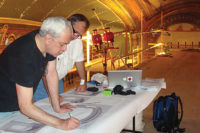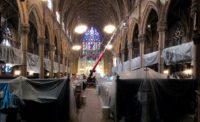
Right in the center of New York’s historic theatre district, lies Foxwoods Theatre, home of the popular Broadway production Spider-Man. Due to the massive size of the performance, the “Spider-Man, Turn Off the Dark” production crew called for the removal and reconstruction to the theatre’s proscenium: the frame surrounding the stage, as well as the sail vault and balconies.
Since the Foxwoods Theatre was constructed using historic elements from both the Apollo and Lyric theatres, originally built in the early 1900s, Jean-Francois Furieri, a third-generation plasterer and President of Iconoplast Designs Inc., was commissioned in 2009 for the large-scale project to to organize and supervise the careful removal of historic plaster.
Furieri is originally from Cannes, France, where he learned from European artisans and now resides in Toronto. He has been used by New York State many times for his specialization in historic plaster restoration and renovation. He managed the logistics and methodology of the Foxwoods project.
The mandate for this project was to retain 100 percent of the historic plaster to cut, crate, transport and store, until re-installation.
“The methodology was very complex, we had to remove historic plaster without breaking it, nor triggering the seismic sensors, while protecting the theatre and the surrounding theatres,” Furieri says. “The harder challenge was the digging of the bedrock.”

About two skids of plaster (various USG stock) were used for the project that took Furieri’s team about four months (the entire project lasted two years). The proscenium removal of the sail vault process, and packaging of the historic plaster was done on scaffolding.
Once all of the historic plaster was removed, a protection plan was developed to protect the remaining historic fabric. The stage apron was removed and the orchestra pit was dug in, where they hit the hardest of granite and quartz bedrock. Core drilling and rock splitters did the work, after the 40,000-pound BROK failed to perform on the rock formation.
“We had to recreate new plaster work from the original plaster work,” Furieri says. “The main issue was to follow the original geometry to make it inconspicuous, as the ornament was not a multiple of the new size.”
The proscenium was widened and heightened by 10 feet, while the sail vault was widened by 10 feet, Furieri says.
“Spider-Man, Turn off the Dark” is considered to be one of the most technically elaborate Broadway shows of all time, featuring aerial stunts with Spider-Man flying over the entire audience. If it had not been for these renovations done by Furieri’s crew, the stunts would not be possible.

There were zero injuries and 100 percent of the historic fabric was removed successfully. The project was completed in 2010.
The products used were SIKA epoxies and USG plasters, while everything else was supplied by O’Briens & Sons, a New York contractor that worked closely with Furieri.
“O’Briens were a … source of unlimited resources and they provided most of the tools, equipment, forklifts, cranes, and carpentry,” Furieri says.
IS NOTHING "SACRED"?
(created in 1890 – author unknown)Furieri’s most recent commission was the restoration of the original concrete statue of the “Sacred Heart,” created in 1890. This commission was for St. Joseph’s Hospital in Toronto.
The 6-foot, 4-inch statue was severely damaged due to weathering and poorly produced restoration work, as well as being coated with irreversible sand and resin. It had to be retooled due to the damage and the coating and was a long and tedious task. The restored statue will be returned to the lobby in St. Joseph’s Hospital and a copy will replace the original for the exterior.
“We removed the white paint and we exposed the coating of sand and resin,” says Furieri. “We tried all paint and varnish remover as well as many diluents and we could not dissolve the resin coating which was up to 3/8 inches thick.
“To restore the statue we had to grind the sand and resin coating. The difficulty was to balance the mechanical removal of the coating and the loss of details due to expansive weathering. We had to recoat the sculpture with gypsum plaster and re-tool the entire surface without any documentation for the original art work.”
The prior preservation process for this project caused more damage to the statue than what the benefits were, hence the “elbow grease” required to restore it.




Report Abusive Comment